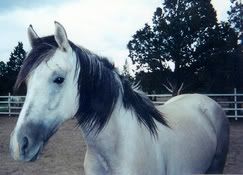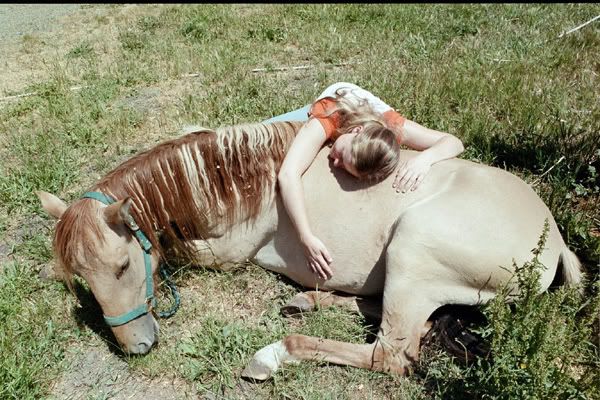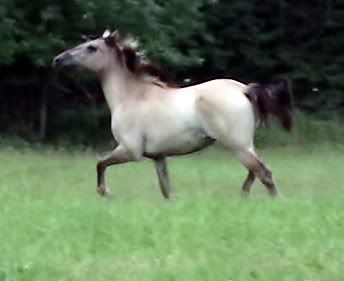|
|
Post by nrly on Jan 17, 2008 23:34:09 GMT -5
she is so big... is she a maiden mare or has she other foals.
nola
|
|
|
|
Post by Michelle Clarke on Jan 17, 2008 23:37:28 GMT -5
Golly......look at all those dirty white horses!!!  I am very excited to have Lynns' mare join us! She will be bred to Charro this year, so we will all be interested in what they will produce! Here is my "dirty white horse":  He is actually a double dilute plus dun (triple dilute??). I belive he is black or bay based. His sire is red based and dam is black based. If he were red based, I am pretty sure we would not see any stripes on him, as those horses tend to be very very light. He has a star on his head that is very visable against his coat color. His mane is major bi-colored and dark in the middle along with his tail. His stripes (and the interior of the mane and tail) have a copper color to them. I am going to send his color test in, but was waiting for the dun to do that along with it. He does NOT sunburn, even in the Texas summer where he is out all day long. He has pigment to his skin and it is a grey color over the pink. His eyes are a little light sensitive when it is very bright out, much like a blue-eyed person. Here is his dorsal, more apparent now, I'll see if I can get a new one:  Here are his front leg bars:  |
|
|
|
Post by desperatehorsewife on Jan 17, 2008 23:47:11 GMT -5
He's cute, Michelle!
|
|
|
|
Post by fantasykiger on Jan 18, 2008 0:00:32 GMT -5
Iwood92 I would be inclined to think maybe you like palomino and creme colored horses  You have some very beautiful horses and I love your mare's brown eyes and that pregnant belly is well just... WOW! You be sure and post pictures when that precious package arrives. |
|
|
|
Post by fantasykiger on Jan 18, 2008 0:04:04 GMT -5
Michelle... I love your 'dirty white horse' I can't wait to see him all grown up in all his glory.
|
|
|
|
Post by sonrisa98 on Jan 18, 2008 0:57:57 GMT -5
I'm going to cut and paste an e-mail from a friend of mine about the cremellos/perlinos and how she feels about the Kiger.
|
|
|
|
Post by sonrisa98 on Jan 18, 2008 0:59:13 GMT -5
It used to be thought that cremellos/perlinos were in fact albinos...and albinos were considered weak and not wanted. This was before DNA/genectic research was available. Now, with genetic color testing available, it's been discovered that "classic" albino (pink skin/eyes) does not exist in horses. What does exist is "dilute" genes. A single dilute gene (also called cream) can produce palominos on sorrels, and buckskins on bays. A horse has to have a parent carrying the cream gene to be a paly/bucky. Where it gets interesting is when two horses, both carrying a cream gene, are bred together---their offspring, if they inherit a cream/dilute gene from both parents are considered "double dilutes". The cream gene is diluted twice---sorrel to paly to cremello, bay to bucky to perlino. These are cream dilutes with blue eyes and are now registered in AQHA. Remember the Smokey's Gray (he was born palomino before greying) gelding you had and tried to get Albino papers on?? He was a cremello and now would be quite an expensive stallion prospect as cremellos/perlinos always produce palys on red-factored horses and buckys on black-factored horses. White (not albino) is also now considered an approved color in AQHA. To be considered white, a horse has white hair, pink skin and dark eyes. White genetics are still being researched. Current thinking is that white is related to the sabino/overo/ spash white in Paints. It is also thought, that it is the sabino gene that creates all the white markings on solid colored horses of any breed. Because of these genetic findings, Paints, with all QH registered bloodlines are now accepted in AQHA (though with the notation that they are have "undesireable" markings on the papers). To confuse things, tobianos are not allowed in AQHA, as that is a different gene not found in the QH/TB bloodlines. The dun-factor gene is totally different and not related to the (cream) buckskin color at all. Buckskins get their black points from the agouti gene that gives bays/ browns/buckys their black legs/ear-tips/mane-tails. The Kigers were based on the primitive dun, and that's what the registry wants.The primitive dun-factor (dorsal/barring/cob-webbing) gene hasn't been totally mapped out, so there is no genetic test for it, yet. But we do know, that a dun has to have a dun parent and a grey has to have a grey parent. Were there grey "kiger-type" horses in the past? Probably---BUT---it was the primitive dun ones that were caught and developed as Kigers. That's what the Kiger breed is now associated with. I always thought that the crop-out QH's with QH bloodlines were QH"s and should have been registered as QH"s all-along---genetic testing has proven me right. Paint coloration has proven to be nothing more than a modification on color genes that were already there. Maybe the discovery,of and the ability to test for the primitive dun gene will help solve the "purity" of the Kiger's. Until then people with "off-colored" kiger-type horses, will want them registered. The Kiger Ass'n., I'm sure, will wait to see what genetic testing reveals, and no matter what the outcome, people should realize that the Kiger Ass'n. has the right to set the rules of what a Kiger should be (at least to them), and what can be registered with them. If you agree, then you look for dun-factored Kiger's; if not, people can always start their own registry and see how many people agree with them :-) For me, a Kiger is a dun. A dun-factor test may prove that all true Kiger's are dun---or maybe not---we'll have to wait and see
|
|
|
|
Post by sonrisa98 on Jan 18, 2008 1:00:09 GMT -5
and to think, I use to own a cremello QH stud that I bought as a weanling and it wasn't registerable in the QH assoc. LOL
|
|
|
|
Post by lindaf on Jan 18, 2008 2:08:17 GMT -5
When is you mare due to deliver? I hope for her sake it's SOON! From what I hear about the outcome fo twin births, I hope it's a single. Beautiful horse.
Linda F
|
|
|
|
Post by lwood92 on Jan 18, 2008 9:10:28 GMT -5
Morgan is supposed to be due at the end of March! I am not sure she will make it that long. She is bred to a dunskin QH so the coloring of the foal should be very interesting. She has been bred before, she is 10 this year and has had two babies that I know of. She is a super sweet mare. We could not be more pleased to have her. As for the color affinity, I think it has just worked out that way!  I never really was attracted to those colors specifically (now I think I am though!  ) It is a funny story, when I picked Solana out from Michelle's herd I brought my husband over and he fell in love with one of Michelle's grulla fillies. When I became interested in breeding he told me I could breed all the grullo horses I wanted (he really likes that color)! So when I started building my herd, all the horses that I picked based on conformation, etc. just happened to be light colored. So my husband teases that he didn't sign on for Dirty White Horses! Now, with Mari (who is a dark dun) I say I have 3 dirty white horses and 1 dirty brown one. |
|
|
|
Post by Brandy Deck on Dec 17, 2009 11:21:48 GMT -5
I am new here, and this topic caught my eye. I have foundation appaloosas. This is a big controversy with app breeders as well. The ApHC allows grey appaloosas in their registry, but the Foundation Appaloosa Horse Registry does not. There is a lot of bickering about whether the appaloosa is a "color" breed or not. The grey gene has a 50% chance of being passed on to the offspring. It will show up fairly quickly. Foals will appear to have goggles. The greying will start in the face and gradually move across the body. I have avoided greys, but I do not think they should be banned. There have been some amazing grey appaloosas through the years that have definately been an asset to the breed. My new Kiger is a beautiful bay. She has a dorsal stripe and the ear lining. She is all Kiger. I woud hate to think of her being banned from registry due to her color.
Brandy
|
|
|
|
Post by Michelle Clarke on Dec 17, 2009 12:28:01 GMT -5
Yes, Brandy, quite the controvery in some breeds for sure!! Many of the Kiger registries do not allow the greys, which is a shame because it was first belived they were the "rare" claybank color...so everyone wanted one, then, opps! Many greyed out and they were ousted along with any foals they produced that were grey. I have three purebred Kigers that are grey from a freezebranded "claybank" mare...
|
|
|
|
Post by kigermustang1 on Dec 17, 2009 18:26:19 GMT -5
What is the difference between a Clay Bank and an Issabella Dun? My friend has an Issabella dun and I have seen a Kiger mare with the exact same coloring. She had what appeared to be a pale pale grey almost white coat except for the ends of some of her hair, (it was white and had an orangy tinge to it.) She looked like she had rolled in mud or clay. Is that how they got the term Clay Bank? If so, does that mean that the term Clay Bank in the Kiger world is the same for Issabella Dun in other breed worlds? Does it also mean that the creme gene could be present in the Kiger gene pool?
|
|
|
|
Post by fantasykiger on Dec 18, 2009 4:22:50 GMT -5
Clay Bank in the Kiger world has black points, no orange tint. The body color is so light creme (almost white) right at birth. Mane and tail black as well as dun characteristics. I think that is what confused folks it was not your typical colored horse that faded to gray everytime. Of course once the points stared to fade you knew it was a gray. I just tell people Kiger's gray differantly or maybe it is just duns. Fantasy a registered claybank as a yearling, she is also the mare on the left in my avatar  |
|
|
|
Post by barbhorses on Dec 18, 2009 11:54:24 GMT -5
I met a Kiger that was bred by Rick Littleton (she was by Silverado) down in Long Beach some years ago. She was sold as a claybank, but she was clearly greying out. This is what a traditional claybank looks like. And yes, it is because it looks like they rolled in clay. This is a Sulphur mare (Sampson x Blossom).  I had this very creamy looking mare (Sulphur's Arista) tested and she came up: ee (homozygous red) aa (black base coat) nn (negative for cream) nn (silver) nn (pearl). What makes her coat look so pale? I have no idea. www.youtube.com/watch?v=4_Nl-YeURNAGuess it is the same modifier that makes this grulla look silver! Yes, I know he looks funny, I think the Sulphur way of being excited makes them look like a deer! lol The Sulphur cannot flag their tails like most other horses.  |
|